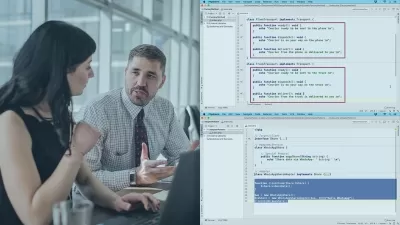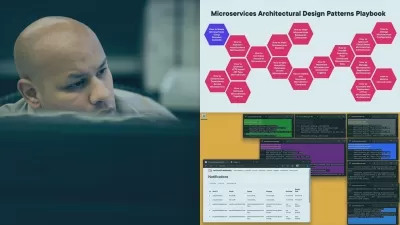Master SOLID Principles For Software Design & Architecture
Kris Code
2:41:37
Description
Guide to mastering SOLID principles for software design & architecture to write maintainable, scalable, and robust code
What You'll Learn?
- You'll learn why, when, and how you should apply the SOLID principles to write higher quality code
- In addition to knowing when to apply the SOLID principles, you'll also learn when and how to violate them, so you could create better overall code design
- Understand the basic foundation of software architecture
- Write better code without having to memorize design patterns
- Learn how to identify poorly written code and robust quality code
- Learn core ideas that describe code quality, like coupling and cohesion
- Take your code quality to the next level and become a better software engineer
- Learn why the SOLID principles matter and how to apply them to real-world problems
Who is this for?
What You Need to Know?
More details
DescriptionIn this course you will learn why SOLID principles are important and how to apply them to write maintainable, scalable, and robust code.
SOLID is an acronym for 5 software design principles that were refined over a long period of time by multiple software engineers to address the core recurring problems in software development.
Take your code quality to the next level
Code quality is important to have, and improving code quality is something that all software engineers should strive for. Luckily, writing quality code is a learnable skill, but it's sometimes hard to know where to start or what to learn next.
Do you know any programming language, but don't know what to do next? Maybe you are more experienced and are looking to add more to your arsenal or refresh your knowledge? If so, then learning the SOLID principles is a very good next step for you.
It doesn't matter if you're a beginner or have a background in software, the SOLIDÂ principles will make you a better software developer and will make you stand out from the crowd.
Build a SOLID foundation for software design and architecture
The goal of this course is to help you understand the core ideas behind software design and architecture that are used by experienced software engineers and architects. All without requiring you to memorize a bunch of object-oriented programming (OOP)Â design patterns.
Patterns only help you in specific situations, but when you encounter a new situation, memorized patterns cannot help you if you don't understand how they work. That's why in this course we'll be focusing on ideas behind the principles, what and why they are trying to achieve, and, most importantly, how they are trying to achieve it.
After taking this course you'll level up your programming skills and will be able to deal with code design problems that are new to you.
Acquire long-lasting skills
In this course I'll present you code examples in Java programming language. However, my goal is not to teach you Java or any other technology, my goal is to teach you the thought process behind writing better code and applying the SOLID principles.
At the end of this course you'll have skills that won't go out of fashion with the next popular technology change. SOLID principles have passed the test of time and are here to stay.
Course overview
Together, in this course we will explore real-world problems that software developers run into on a daily basis instead of studying textbook examples that barely represent reality.
You'll find a mix of relevant theory, practical coding exercises that will be done on-screen, and quizzes for you to take on your own. The quizzes are designed to convey the most important things, and you'll even be able to use them as a cheat sheet later.
On top of all this, the course has as little technical jargon as possible and IÂ try to explain things in everyday language.
The course is divided into 5 sections, one for each of the principles:
Single Responsibility Principle
Open-Closed Principle
Liskov Substitution Principle
Interface Segregation Principle
Dependency Inversion Principle
In each section we cover the required theory, and after that you are presented with a quiz that helps you better remember the theory before proceeding to a practical code example. After practical code examples we have a few more lectures to fill in any remaining gaps or explore things by looking at the bigger picture, we also explore when it would make sense to intentionally go against the SOLID principles for a better overall code design. The last part of each section is another quiz to further solidify your newly acquired knowledge.
By the end of this course you will be able to identify common problems in code, and you'll know how to correct them.
So, with all being said, if you're looking to improve your skills and write better code, look no further, because this course is for you.
Who this course is for:
- People who care about the quality of their code and want to improve it
- Everyone who wants to start learning about software architecture
- Beginners who want to take their skills to the next level, but don't know where to start
- More experienced developers who want to strengthen their abilities
In this course you will learn why SOLID principles are important and how to apply them to write maintainable, scalable, and robust code.
SOLID is an acronym for 5 software design principles that were refined over a long period of time by multiple software engineers to address the core recurring problems in software development.
Take your code quality to the next level
Code quality is important to have, and improving code quality is something that all software engineers should strive for. Luckily, writing quality code is a learnable skill, but it's sometimes hard to know where to start or what to learn next.
Do you know any programming language, but don't know what to do next? Maybe you are more experienced and are looking to add more to your arsenal or refresh your knowledge? If so, then learning the SOLID principles is a very good next step for you.
It doesn't matter if you're a beginner or have a background in software, the SOLIDÂ principles will make you a better software developer and will make you stand out from the crowd.
Build a SOLID foundation for software design and architecture
The goal of this course is to help you understand the core ideas behind software design and architecture that are used by experienced software engineers and architects. All without requiring you to memorize a bunch of object-oriented programming (OOP)Â design patterns.
Patterns only help you in specific situations, but when you encounter a new situation, memorized patterns cannot help you if you don't understand how they work. That's why in this course we'll be focusing on ideas behind the principles, what and why they are trying to achieve, and, most importantly, how they are trying to achieve it.
After taking this course you'll level up your programming skills and will be able to deal with code design problems that are new to you.
Acquire long-lasting skills
In this course I'll present you code examples in Java programming language. However, my goal is not to teach you Java or any other technology, my goal is to teach you the thought process behind writing better code and applying the SOLID principles.
At the end of this course you'll have skills that won't go out of fashion with the next popular technology change. SOLID principles have passed the test of time and are here to stay.
Course overview
Together, in this course we will explore real-world problems that software developers run into on a daily basis instead of studying textbook examples that barely represent reality.
You'll find a mix of relevant theory, practical coding exercises that will be done on-screen, and quizzes for you to take on your own. The quizzes are designed to convey the most important things, and you'll even be able to use them as a cheat sheet later.
On top of all this, the course has as little technical jargon as possible and IÂ try to explain things in everyday language.
The course is divided into 5 sections, one for each of the principles:
Single Responsibility Principle
Open-Closed Principle
Liskov Substitution Principle
Interface Segregation Principle
Dependency Inversion Principle
In each section we cover the required theory, and after that you are presented with a quiz that helps you better remember the theory before proceeding to a practical code example. After practical code examples we have a few more lectures to fill in any remaining gaps or explore things by looking at the bigger picture, we also explore when it would make sense to intentionally go against the SOLID principles for a better overall code design. The last part of each section is another quiz to further solidify your newly acquired knowledge.
By the end of this course you will be able to identify common problems in code, and you'll know how to correct them.
So, with all being said, if you're looking to improve your skills and write better code, look no further, because this course is for you.
Who this course is for:
- People who care about the quality of their code and want to improve it
- Everyone who wants to start learning about software architecture
- Beginners who want to take their skills to the next level, but don't know where to start
- More experienced developers who want to strengthen their abilities
User Reviews
Rating
Kris Code
Instructor's Courses
Udemy
View courses Udemy- language english
- Training sessions 39
- duration 2:41:37
- Release Date 2023/12/28















